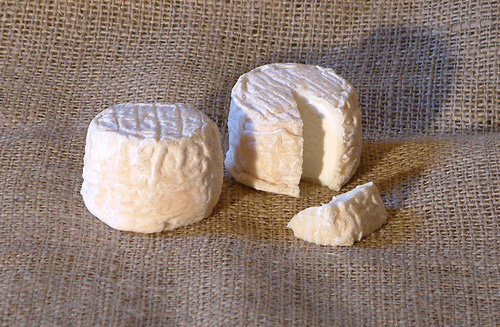Crottin de Chavignol Info
Frances Quintessential Goat Cheese
Yes, this is the quintessential goat cheese from France and one of the worlds finest goat cheeses made only in the Loire Valley of France. This recipe shares the history and details of one of the most classic goat cheeses from France.
A Bit of History
Our story for this cheese takes place along the Loire River of France. This river is one of the longest rivers in France where its headwaters begin in the Auvergne mountains of south central France then flowing north and eventually turning west to the Atlantic ocean.
This region of the Loire Valley is located just to the south and west of Paris. It is a rich agricultural area and is known especially for it's wines and many famous goat cheeses.
This river marks the northern extent of the Saracen advance as they moved through Spain and into France. The name Saracen, however, is used locally to apply to the Arabs, Berbers, Moors and Turks who attacked, occupied or harassed the country until the 18th century.
One of the great contributions from the Saracens was the introduction of their goats to the region and their methods of making cheese that came with them. Goats, rather than sheep, were the most sensible choice for these travelers because of the range of pasture they could adapt to and the ease with which they could be moved.
his part of the Loire Valley has also become known as the "Land of the Kings."
Today their influence can be seen by the numerous castles that dot it's landscape. These most probably date back to the troubled times of conflict and bloodshed between the rulers of England and France. Yes, not much has changed over the years.
The Village of Chavignol
The "Crottin de Chavignol" name is linked to its name-sake village of Chavignol where the cheese has been made since the 16th century.
This village also neighbors another very famous village named Sancerre and a very important French white wine is attached to that name as well.
At one time, there were many variations of the cheese, each with it's own unique character, and all named for the village from where they were produced.
Variations in Style
The Crottin de Chavignol is a small cheese made of goats milk. In its young stage of life, it is about 2 inches in diameter and 1 inch in height weighing in at about 2 oz. per cheese. In it's youth it develops a rather distinctive white surface coat due mostly to natural yeast and a natural geotrichum bacteria. As the rind develops, it will take on a rather unique rippled appearance due to this particular surface growth. The young cheese has a subtle nutty flavor that shows off the quality of the local goats milk. The body of the young cheese is solid and compact.
As it ripens further you will find that the body becomes crumbly and the mold on the rind is replaced by one with a bluish color. The blue doesn't mean that the cheese is bad but that a more complex flavor has developed. The true flavor of this will be when the rind is consumed with the cheese body.
The cheese will undergo varying lengths of aging from several weeks to 4 or many more months - thus producing a range of very different flavors.
Crottin de Chavignol can be eaten at various stages of the maturity process.
- After 8 days weighs 140gr (5oz) and has a strong nutty taste.
- After 21 days the cheese begins to come into its own with a much more complex flavor and the surface begins to show various molds developing.
- After 4 months, the cheese weighs only 40gr (1.5oz) and has turned into a more complex cheese. The surface at this point is covered with darker dried molds and the paste is very dense and strong in flavor.
- When the cheese is allowed to age even longer the surface will turn a grey/brown color and the body of the cheese will become very dry. The flavor becomes very complex but time to taste it is essential.
The Evolution of Crottin
Originally, "Crottin" was the traditional term for a fully ripe cheese with long aging to the extent of being described as "shrunken, black, and hard to the extreme limit of edibility" by Pierre Androuet the famous French cheese specialist. I still see a group of people presenting these very same traditional cheeses at the cheese festival in Bra Italy. They do look like dark truffles, just dug up from the forest floor. I actually do like these longer aged cheeses but the flavor is strong and may be an acquired taste.
Androuet also favored the medium aged cheeses beginning at 21 days and aging for up to a couple of months. He felt this cheese to be more "approachable" to his customers yet with the traditional Crottin character. At this point the flavor develops more fruity flavor as well as a softening of the paste near the surface.
One of my favorite writers on French Cheese is Patrick Rance in his book "French Cheese." He writes about selling a larger version of Crottin that had been very fresh and open in texture as well as many of the medium ripened cheeses of similar style but with local character and with different names. He also mentions that this was not the traditional Crottin of years past. He speaks of only the gnarly, aged, grey/brown cheeses traditionally meriting the name of "Crottin de Chavignol." Times change along with tastes and the commercial presentation of much younger cheeses are mostly what we find today as "Crottin de Chavignol."
s the larger commercial production increased, these cheeses became younger with a minimum ripening time of 10 days (AOC). As the AOC applied its protection to this cheese, the Crottin style became more of a younger cheese and sold in the 10-60 day window. In the US these cheeses must be either made from pasteurized milk or aged more than 60 days.
Unfortunately, the AOC rules also allow the use of pre-frozen curd and the 10 day minimum aging does not bring the cheese into it's true character. They also forced the exclusion of cheeses made outside this region that had been made under similar process but sold under different names. In this case the AOC has shown its colors for the large commercial cheese makers and the loss of many regional cheeses has been the result.






































